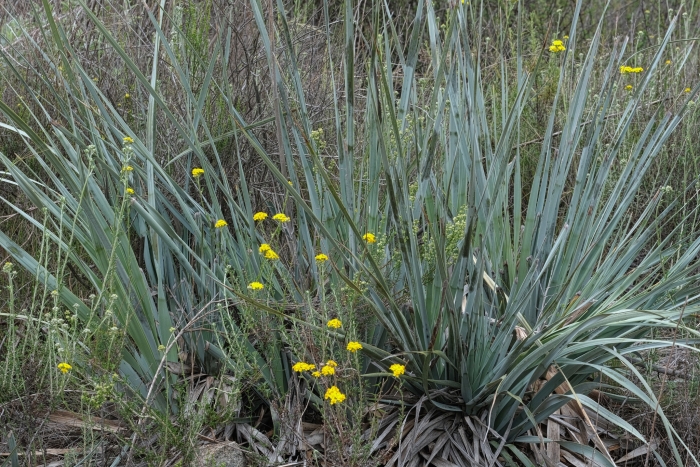Dehesa Nolina
(Nolina interrata)
Dehesa Nolina (Nolina interrata)
/
/

© Madeleine Claire
CC BY 4.0
Image By:
© Madeleine Claire
Recorded By:
Copyright:
CC BY 4.0
Copyright Notice:
Photo by: © Madeleine Claire | License Type: CC BY 4.0 | License URL: http://creativecommons.org/licenses/by/4.0/ | Uploader: madily | Publisher: iNaturalist |

























Estimated Native Range
Summary
Nolina interrata, commonly known as Dehesa nolina, is a perennial succulent native to chaparral and oak woodlands in San Diego County, California, and northern Baja California, Mexico. It is characterized by its branching stem and dense rosettes of blue-green, strap-like leaves that can reach up to 3 feet in length. The leaves have finely serrated margins and a waxy coating, which helps the plant conserve water. During the flowering season, which occurs from late spring to early summer, Dehesa nolina produces an erect inflorescence that can grow up to 5 feet tall, bearing clusters of small, whitish flowers that are not particularly showy but are attractive to pollinators.
Dehesa nolina is valued for its drought tolerance and architectural form, making it a suitable choice for xeriscaping, rock gardens, and as a focal point in water-wise landscapes. It is also used in native plant gardens to support local ecology. This plant prefers full sun to light shade and requires well-drained soils, ideally with a rocky or sandy composition. While it is rare and has a limited distribution in the wild, it is protected within its native habitat. In cultivation, it is important to avoid overwatering to prevent root rot. Dehesa nolina is relatively low-maintenance and can be propagated by seed or division of clumps.CC BY-SA 4.0
Dehesa nolina is valued for its drought tolerance and architectural form, making it a suitable choice for xeriscaping, rock gardens, and as a focal point in water-wise landscapes. It is also used in native plant gardens to support local ecology. This plant prefers full sun to light shade and requires well-drained soils, ideally with a rocky or sandy composition. While it is rare and has a limited distribution in the wild, it is protected within its native habitat. In cultivation, it is important to avoid overwatering to prevent root rot. Dehesa nolina is relatively low-maintenance and can be propagated by seed or division of clumps.CC BY-SA 4.0
Plant Description
- Plant Type: Succulent
- Height: 2.5-3 feet
- Width: 2-3 feet
- Growth Rate: Slow
- Flower Color: Cream, White
- Flowering Season: Spring, Summer
- Leaf Retention: Evergreen
Growth Requirements
- Sun: Full Sun
- Water: Low
- Drainage: Fast, Medium
Common Uses
Deer Resistant, Drought Tolerant, Fire Resistant, Low Maintenance, Rock Garden
Natural Habitat
Native to chaparral and oak woodlands in San Diego County, California, and northern Baja California, Mexico
Other Names
Common Names: Dehesa Nolina
Scientific Names: , Nolina interrata,
GBIF Accepted Name: